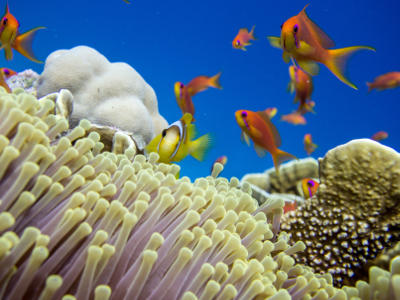The Missing Kingdom: Why Fungi Must Be Central to Conservation Strategy
28 December 2025
Published online 28 August 2017
New research unveils the mechanism by which corals-associated algae cope with highly saline waters.

© Anna Roik
It’s the algae – the corals’ symbiotic partners – that accumulate floridoside, and the molecule is produced directly from photosynthesis.
In a study published in Science Advances, researchers from KAUST, NYUAD and the University of Southampton, have singled out floridoside as a potentially exceptional osmolyte, or a compound that would enable algae (and by extension corals) to match their own salinity levels to the surrounding environment.
“One of the main motivations for this study was to finally establish whether a connection exists between the high salinity of the Red Sea and PAG and the fact that they host the world's most thermotolerant corals,” says Christian Voolstra, marine scientist at KAUST and lead author of the study.
Studying the unicellular algae inhabiting stony corals, known as Symbiodinium, and how it alters its metabolite content to respond to high-salinity, the scientists discovered that it produces copious floridoside, both in vitro and in their coral host animals.
“The degree of abundance of floridoside is proportional to the increase in salinity level,” says Voolstra.
The capacity to produce floridoside seems to be present in a range of Symbiodinium from different environments, he adds. “But it is unclear at the moment whether Symbiodinium from the Red Sea and PAG have a particular ability to produce high levels of floridoside.”
On average, each litre of ocean water carries 36 to 37 grams of salt. In the Red Sea, however, this number is between 39 and 43 grams. The PAG boasts the world's most saline water at around 40 to 50 grams of salt per liter of water. This is a result of warmer temperatures and the absence of connected rivers that would otherwise add significant volumes of fresh water and dilute salt content.
“Fifty grams per liter is the definitive threshold above which corals can no longer cope,” explains Voolstra, who says that this study is the first of its kind to link stress tolerance and salt-resistance among corals.
“Plants use osmolytes' anti-oxidative potential to survive in highly saline environments, and we speculate that corals do the same” says Voolstra, who explains that floridoside not only deals with salt-induced stress, but has a secondary function to scavenge reactive oxygen species (ROS), a product of oxygen metabolism and an important component in the mechanism by which corals endure thermal stress.
“We still need to run some tests before we can infer this without any doubt, but our findings hint that higher salinity could be the secret to Red Sea and PAG corals' stress tolerance,” he adds.
Ameer Abdulla, an associate professor at the Global Change Institute and Center of Biodiversity and Conservation Science in the University of Queensland in Australia, says these findings are very significant from an evolutionary point of view, because they highlight the corals' exceptional physiological and chemical tolerance. “This may partly explain how they were able to spread to some of the highest latitudes of global coral reef distribution and thrive in these extreme conditions over time,” says the researcher who was not involved in Voolstra’s study.
According to Abdulla, the dual ability of floridoside to protect against hot and highly saline waters is “a clear example of evolutionary success, where species that evolve to adapt to the prevailing conditions succeed over others and persist through time.”
Now, for Voolstra and his colleagues, the next step will be to validate the results they obtained in the lab.
“The general mechanism of floridoside is important for algae and by extension for corals, and I believe this will be also true at the scale of reef ecosystems, not only in the laboratory,” says Voolstra.
doi:10.1038/nmiddleeast.2017.129
Stay connected: